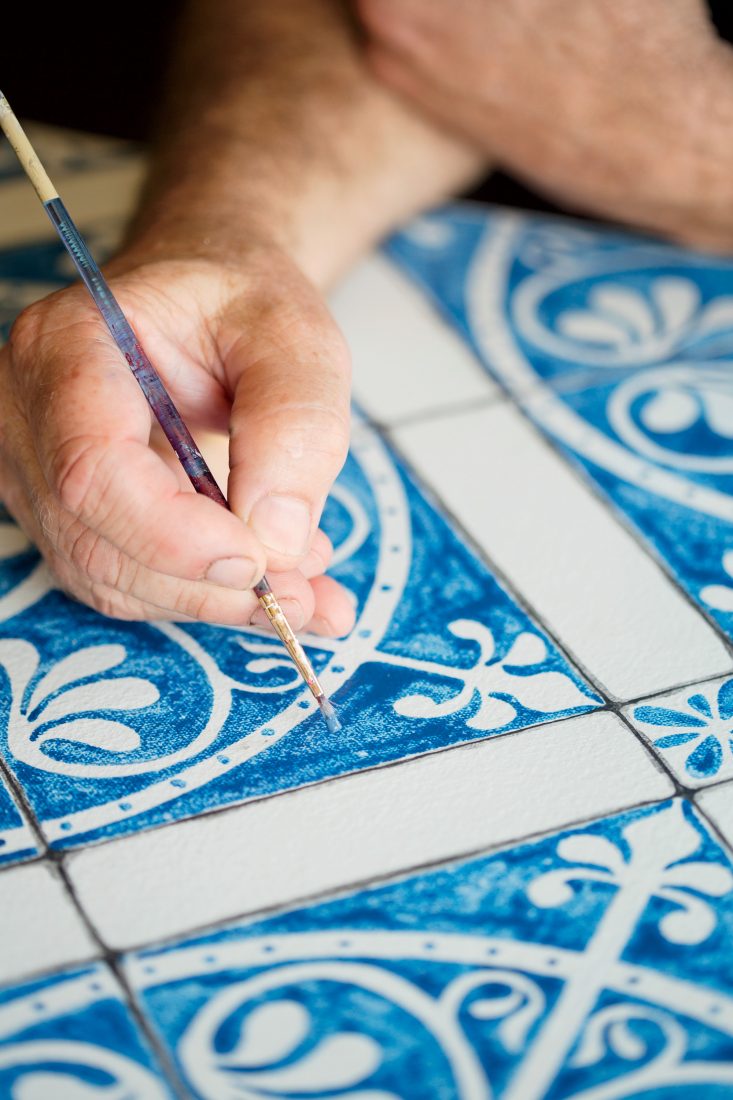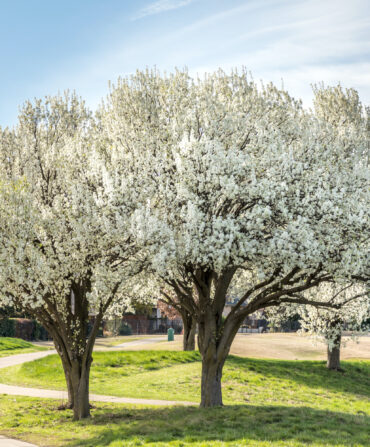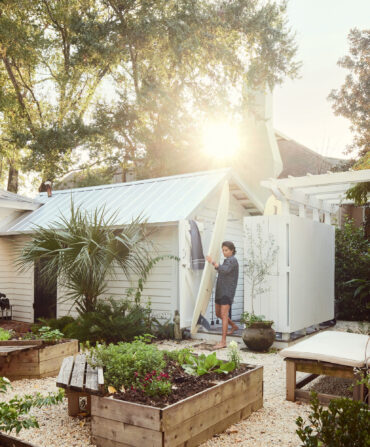When the caretakers of one of Savannah’s most notable historic homes, the 1819 Owens-Thomas House, sought to re-create an early nineteenth-century floorcloth that had once graced the public entry hall, they started with only a few surviving scraps of the intricate original design. In the hands of the siblings Ginny and Joe Lascara, restoration experts who specialize in the smooth painted floor coverings that were all the rage in the colonial era, those tattered clues spoke volumes. Every year, seventy thousand visitors now admire—and tread on—the wall-to-wall reproduction they created from those scraps.

Photo: Patricia Lyons
The Lascaras in front of a reproduction of an eighteenth-century John Carwitham design.
The Lascaras’ Virginia Beach–based Black Dog Gallery, which also handles period frame reproductions, first tackled floorcloths two decades ago after Ginny studied them in her former position as an associate curator of prints and maps at the Colonial Williamsburg Foundation. “It was exciting to use my creative side to actually make the floorcloths, and rewarding to see how they transform interiors to the appearance they likely had in history,” Ginny says.
The Lascaras have since created floorcloths for historic sites including Mount Vernon and the Nathaniel Russell House in Charleston, South Carolina. But you don’t have to live in a registered landmark to want one, as their growing clientele of private home owners proves.
Floorcloths used a common material of the era, sturdy woven cotton, to solve an equally common problem—protecting and adorning bare wood floors. They had extra appeal in the sweltering South, where they often replaced heavy wool rugs in the summer. Plain floorcloths were, quite literally, blank canvases awaiting artistic flourishes. Many eighteenth-century designs adopted London engraver John Carwitham’s intricately geometric patterns, from his 1739 book, Various Kinds of Floor Decoration. By the 1800s, buyers could flip through pattern books to order from several American floorcloth manufacturers.

Photo: Patricia Lyons
Pattern Play
Joe Lascara stenciling.
The Lascaras’ craft is more personal, with just a few custom floorcloths in progress inside their busy-but-orderly workshop. (When they first started, they often commandeered their mother’s garage.) Each project begins with stretching cotton duck, the tightly woven canvas used in awnings and theater sets, on a simple wooden frame. They then seal and stiffen the canvas with six coats of exterior-grade latex—an admitted improvement upon history. “Period floorcloths used linseed oil mixed with pigments and turpentine but weren’t as durable and didn’t survive high traffic and humidity, which is why they are underrepresented in eighteenth-century restoration now,” Ginny says.

Photo: Patricia Lyons
Carved blocks used for printing.
After a light sanding, an in-house artist (one of three, depending on the design) hand paints and employs custom stencils to apply artwork that the Lascaras select from their archive of traditional patterns. Greek keys, compass roses, and faux marbling are mainstays, as are those M. C. Escher–esque designs by Carwitham. Finally, three coats of clear acrylic and a top layer of bowling alley wax help the one-of-a-kind floor art resist cracking, warping, and rolling. “The materials are the best of the best,” Joe says. “We’ve decided that if we’re going to do these, we’re going to do them right.”
Pricing ranges from $28 to $45 per square foot. A typical 5′ x 7′ floorcloth costs around $1,000, though the Lascaras can go much bigger. They recently finished a 65-foot-long runner for a newly opened section at Monticello, and a room-size work, like the 24′ x 30′ behemoth commissioned for a private residence in South Carolina, can soar up to $11,000.
The Owens-Thomas House floorcloth presented special challenges. Not only did the Lascaras draw upon all their historical resources to best envision the multicolor floral design from the remnants of the original, but they also devised the procedures that could re-create it. This entailed hand carving four different, but overlapping, print block patterns and even incorporating a striking pointillism technique (think Seurat’s famous painting of well-dressed Parisians relaxing by the Seine), perhaps achieved in colonial days by square nail heads dipped in paint.

Photo: Patricia Lyons
Floor Show
A floorcloth inspired by eighteenth-century Mark Catesby natural history prints.
Ironically, such historic techniques ushered in the decline of floorcloths. “Block-printed floorcloths were the precursor to linoleum,” Ginny says. “So when actual linoleum was invented in the 1850s, it completely took over.”

Photo: Patricia Lyons
A finished floorcloth.
Still, floorcloths offer a bespoke artistry difficult for any other floor covering to match, and are regaining stature even with people who aren’t tethered to history. “You can have any pattern on them that you can imagine—that’s design freedom,” says Ralph Harvard, a Virginia native and New York City–based interior designer who often uses the Lascaras’ work for his projects on the Eastern Shore of Virginia and in Charleston.
Naturally, the Lascaras also view floorcloths as unique. “They can become very personal,” Joe says. “Nothing here is mass-produced—every inch is hand made by an artist with a brush, and the whole process is very satisfying. In the end, a floorcloth is art and geometry and history combined.”








